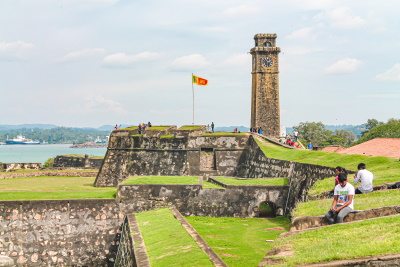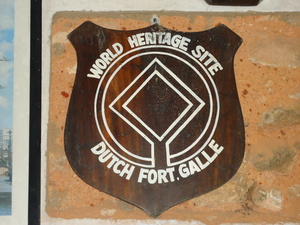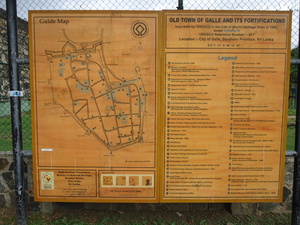Old Town of Galle

The Old Town of Galle and its Fortifications illustrate the interaction of European architecture and South Asian traditions.
In the early 17th century Galle was taken from the Portuguese by the Dutch. They established the still-existing fortress and ramparts as well as its urban look. European building materials were replaced by those more convenient in Asia such as coral and granite, and verandahs and shaded streets were added to suit the climate. Particularly notable also is its 17th-century sewer system flushed by seawater.
Community Perspective: The fort and city center are in good condition and reviewers find the place quite charming.
Map of Old Town of Galle
Community Reviews
Nan

It’s quite clear why the Portuguese and then the Dutch chose Galle as a strategic location. The peninsula naturally offers protection against external threats. The walls encompass the entire old town, with the main fortifications and the sole entry gate facing north towards the mainland. The total width of the entry point is only 400 meters, making it easily defensible.
Within these walls, one can discover numerous colonial buildings from various periods. The most notable structures, aside from the fortifications, are the churches and the administrative buildings near the old entry gate. However, it’s challenging to highlight any specific building. For us, the experience was primarily about strolling through the city and soaking in the views.
Galle is often praised for its culinary offerings. The city is lively, with a plethora of dining options and a walkable old town. This was something we initially struggled to appreciate during our first days in Sri Lanka. Only after venturing into the countryside and realizing the difficulty of finding good food elsewhere did we come to fully value what Galle has to offer. Personally, Galle is the one place where I could have envisaged extending my stay.
Getting There
The World Heritage Site (WHS) encompasses only the fortification-enclosed peninsula. Within the walls, most hotels occupy historic buildings, so if you’re seeking a luxury or beach hotel, you’ll need to look outside the fortifications.
For those arriving in Sri Lanka by plane (or departing), you can arrange for a driver to take you directly to or from the airport to Galle, bypassing Colombo. I have mixed feelings about this, but Colombo isn’t essential to visit for a world heritage traveller. We traveled from Colombo and stayed for two days before proceeding to Sinharaja and Udawalawe National Park. In retrospect, Galle would have been an ideal final stop to unwind after an extensive tour of the country.
While You Are There
Along the coast, there are numerous turtle sanctuaries. It should be self-evident, but please ensure they are accredited by third parties and treat the animals humanely before paying for entry.
A day trip to Sinharaja is entirely feasible with a driver.
Between Colombo and Galle, you’ll find several Bawa-designed locations, with the Lighthouse hotel being the closest. Continuing south, you can visit the Ruhuna University campus. My personal highlight was visiting Kathaluwa Poorvarama Maha Viharaya, which boasts remarkable paintings. These, along with Bawa’s works, may eventually be added to the tentative list.
Michael Turtle

There's a really pleasant atmosphere in the streets of the old town of Galle. The architecture has that really interesting mix of European colonialism and South Asia. What I liked was that, although there are quite a few hotels and restaurants, not all of the Old Town felt touristy. There are still quite a few people living here and it has an authentic community.
There are great views along the coastline and it's worth walking the old fortifications to see that side of things.
Read more from Michael Turtle here.
Frederik Dawson

If the list of world heritage site is Sri Lanka national history book, it will definitely start with Anuradhapura as the starting point of Sinhalese culture and end with Galle as the starting point of colonial period. Galle is a unique cultural world heritage site as it is not related to Sinhalese culture or Buddhism at all; visiting Galle is truly another chapter of Sri Lanka history.
Galle is located in the small peninsular and surrounded by the mighty fortifications system built by Portuguese and developed by Dutch. Galle was the important port of call that was a part of spice maritime route; as the result, Gall has unique atmosphere of cultural exchange of local people, Muslim, Dutch and British. At present, Galle has been regarded as one of best-preserved colonial cities in South Asia.
During my visit, there was a large construction of new road surface, so Galle I saw was a big construction site with many piles of rock and sand for concrete road; however, these were unable to destroy the charm of Galle. People are extremely friendly, and each alley has its own characteristic, really similar with mosque area of George Town, Penang. The main attraction of Galle is the fort, the grandest is the northern part with comprise of three bastions, star, sun and moon, a real engineering wonder; however, the southern part is my favorite with extremely beautiful view of amazing Indian Ocean, lighthouse and lovely mosque. The city center around Dutch church is also nice with unique Holland atmosphere.
Galle is an easy and nice place to enjoy, this is not a must place to visit in my opinion, but visiting Galle is the complete historical lesson from colonial era to contemporary tsunami tragedy of this beautiful country, Sri Lanka, so why not visit this town is maybe the hardest question to answer.
Rob Wilson
Galle Fort is a beautiful place, but is, of course, almost overwhelmed by the horrors of the Asian Tsunami. So many people there must have lost everything.
If you are in Sri Lanka you should undoubtedly visit this place.
Solivagant

We have just visited post-Tsunami Galle (Mar 2005). If you are in Sri Lanka you should DEFINITELY try to go there - both because the locals need tourists and because the old town is as delightful as ever. As far as we could make out the majority of the old town escaped the direct effect of the Tsunami (it is both protected by the ramparts and partially built on a rise) and the guest houses and restaurants are fully working. Unfortunately the same cannot be said of the area outside the walls. Grass is growing on the cricket ground again and the railway and bus services are working but many of the structures facing the sea are destroyed.
The NGOs seem to have done (and are still doing) a wonderful job - but the same cannot be said for the Sri Lankan government - which seems paralysed by corruption, incompetence, lack of skills, inertia, bureaucracy and political infighting. Its suggested rule that no building can take place within 100 metres of the shore line (possibly including surviving buildings) is causing despondency and confusion among locals whose little piece of land is their only hope of a livelihood - suspicion abounds that such "forbidden areas" will find their way into the hands of big developers (politically connected of course!). Schools are not yet properly working and we heard of families whose children are unable to register anywhere (eg in other areas where they have relatives) because their papers have all been washed away. The army is noticeable by its absence when it should surely be building wooden structures to get people out of the tents which will not be suitable for the upcoming monsoon. The government has complained that it hasn’t seen any of the money promised by Western governments – but this is because it has been tardy in coming forward with properly thought through projects. Even the locals expect a large part of any monies reaching Sri Lanka through the government to “disappear”. It is hardly surprising that the government newspapers adopt a negative stance towards the NGOs, accusing them of overlapping and being uncoordinated – they are showing up the government’s own lack of action and providing a means by which monies can reach the locals without providing an opportunity for “siphoning off” by politicians and officials!
Els Slots

The Dutch connection makes Galle an interesting place to visit (for me, as I am Dutch myself). Especially the church (Groote Kerk) and some of the little streets looked very familiar. Hire a bike, and you feel like you are in Holland.
The new part of Galle is hell, but the old town I found quite charming (though very small).
Community Rating
- : Disnsam Dutchnick Ingatastic
- : Christravelblog Mkandasa PabloNorte Travelure Mikita M
- : Eric PK Vernon Prieto Stanislaw Warwas George Gdanski Rodinia Jezza Juropa Priyaranjan Mohapatra Zach Sturuss
- : Martina Rúčková Wojciech Fedoruk Lichia Cmtcosta Inomusay Rich Forrest Alejandro Lau
- : Els Slots Joyce van Soest Frederik Dawson Philipp Peterer Ivan Rucek Bernard Joseph Esposo Guerrero Randi Thomsen Svein Elias Shandos Cleaver Michael anak Kenyalang Tevity NonDuality Philipp Leu Aj.daamen Ralf Rotheimer
- : Mikko Peter Lööv Szucs Tamas Geert Luiken Nan Rickard Alfredsson Alexander Lehmann Hammeel Carlo Sarion Adrian Turtschi Kristin Akhilpreeti Javier
- : Solivagant Lucio Gorla Tarquinio_Superbo Richardleesa
- : Lukasz Palczewski Zoë Sheng
- : Dylan
Site Info
Site History
1988 Inscribed
Site Links
Unesco Website
Official Website
Related
In the News
Connections
The site has 22 connections
Art and Architecture
Constructions
Damaged
Geography
History
Human Activity
Individual People
Religion and Belief
Timeline
Trivia
WHS on Other Lists
World Heritage Process
Visitors
287 Community Members have visited.

